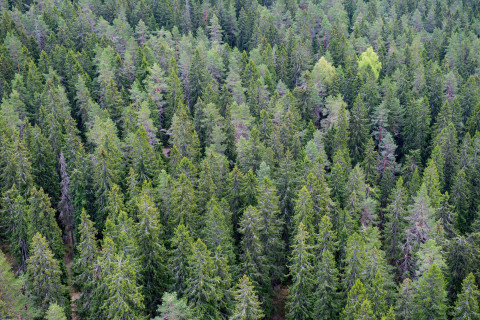Agriculture and forestry have transformed much of Europe – but truly wild places still exist!
Researchers from the Geography Department of Humboldt-Universität zu Berlin led the creation of the first map of Europe’s last wild forests, including more than 1.4 million hectares in 34 European countries.
“It is not that these forests were never touched by man, this would be hard to believe in Europe” explains Dr Francesco Maria Sabatini, lead author of the study.
“Still, these are forests where there are no clearly visible indications of human activities, maybe because blurred by decades of non-intervention, and where the ecological processes follow a natural dynamics”.
The compilation of the map was a huge task, according to the authors.
“We contacted hundreds of forest scientists, experts and NGO activists from all over Europe asking to share information on where to find such forests in their country. Without their direct engagement we could have never been able to build our database, which is the most comprehensive ever compiled for Europe”.
The study, recently published in the journal Diversity & Distributions, highlights that primary forests in Europe are generally very rare, located in remote areas, and fragmented into small patches.
“The European landscape is the result of millennia of human activities, so it is not surprising that only a small fraction of our forests are still substantially undisturbed” explains Prof Tobias Kuemmerle (HU), also an author of the study.
“Although such forests only correspond to a tiny fraction of the total forest area in Europe,” he continues, “they are absolutely outstanding in terms of their ecological and conservation value. Primary forests are the only places where many endangered species occur, and scientists consider them as natural laboratories for understanding people’s impact on forest ecosystems. Knowing where these rare forests are is therefore extremely important, but until this study no unified map existed for Europe.”
The preservation of primary forest cannot taken for granted, not even in Europe
The study also shows that the preservation of primary forest cannot be taken for granted, not even in Europe. The majority of these forests are small, fragmented, and interspersed in human-dominated landscapes, which makes them particularly prone to human disturbance. Even if the majority (89%) of the primary forest mapped is in protected areas, a high fraction (54%) is currently not under strict protection. This means that, at least in some European countries, timber harvesting or salvage logging may jeopardize the untouched nature of these forests.
“Wide patches of primary forest are being currently logged in many mountain areas, for instance in Romania and Slovakia or in some Balkan countries. A soaring demand for bioenergy coupled with high rates of illegal logging, are leading to the destruction of this irreplaceable natural heritage, often without even understanding that the forest being cut is primary,” said Prof Miroslav Svoboda, University of Life Science in Prague (CZ), and co-author of the study.
“Ironically”, he proceeds, “in many cases logging is even done legally, also within national parks. Primary forests have an exceptional value, both environmental and cultural, and preserving their integrity should be a priority of any EU environmental strategies.”
Mapping for protecting, mapping for restoring
But how can the map just published help protecting primary forests? “We clearly demonstrated that the distribution of remaining primary forest is the result of centuries of land use and forest management,” said Dr Sabatini.
In his view, understanding the anthropogenic pressures behind the current distribution of primary forests can inform protection and restoration efforts.
“Interestingly, we used the map to calibrate a model highlighting areas where land-use pressure is low, so to predict where other patches of primary forest not yet mapped are likely to occur. Even if these areas will prove, in the end, devoid of primary forest, still these are areas where restoration initiatives may have relatively low opportunity-costs”.
Funding and support:
The work has received funding from the European Union’s Horizon 2020 research and innovation programme under the Marie Sklodowska-Curie grant agreement No 658876.
The project is entitled: ‘Co-Benefits and Conflicts between CO2 sequestration and biodiversity conservation in European Forests’ (FORESTS and CO) and received support of the European Forest Institute (EFI) under the Programme ‘Sustainability and Climate Change’, the Vegetation Science Group of Masaryk University (Brno, CZ), and the Rubenstein School of Environment and Natural Resources (University of Vermont, USA).
Publication: Sabatini, F. M., S. Burrascano, W. S. Keeton, C. Levers, M. Lindner, F. Pötzschner, P. J. Verkerk, J. Bauhus, E. Buchwald, O. Chaskovsky, N. Debaive, F. Horváth, M. Garbarino, N. Grigoriadis, F. Lombardi, I. M. Duarte, P. Meyer, R. Midteng, S. Mikac, M. Mikolas, R. Motta, G. Mozgeris, L. Nunes, M. Panayotov, P. Ódor, A. Ruete, B. Simovski, J. Stillhard, M. Svoboda, J. Szwagrzyk, O.-P. Tikkanen, R. Volosyanchuk, T. Vrska, T. M. Zlatanov, and T. Kuemmerle. 2018. Where are Europe’s last primary forests? Diversity and Distributions. DOI: 10.1111/ddi.12778
Link to the study: https://onlinelibrary.wiley.com/doi/full/10.1111/ddi.12778
Link to the project: https://www.geographie.hu-berlin.de/en/professorships/biogeography/projects/past-projects/forests/forests_start
Link to Research blog: https://forestsandco.wordpress.com/
Link to the map: Primary forests in Europe



